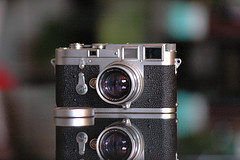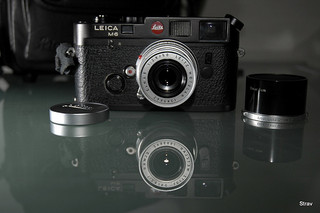Leica M3 and M2
/The Leica M3 is perhaps the one camera that does not actually require an introduction. Voted by STUFF Magazine and Ebay as the “Top Gadget of All Time”
The epitome of vintage style, the Leica M3?s modern incarnations are still held as pinnacles of camera design and lusted by photographer all over the world.
Just the fact that since the Leica M3?s introduction 1954, the basic design of Leica M cameras has not really changed is a testament to how well conceived the Leica M3 is. In fact, one could argue that Leica built such a great camera that they haven’t really done much else since.
The Leica MP, introduced in 2003, nearly 50 years after the Leica M3, is just an inferior, and far more expensive, modern copy.The Leica M3 is Leica’s greatest achievement and also a stark reminder of it’s glorious past.
The Leica M3 was in production for 13 years. Do you know how many M cameras Leica has released in the last 13 years? Eight! That’s roughly one camera every 18 months. You have the Leica M7, MP, M8, M8.2, M9, M9P, M-E and the Leica M Type 240. Leica have become just like every other camera manufacturer in the digital world, pumping out a new camera every 18 months to two years. That’s not even counting their partnership with Panasonic!
In 1954 the Leica M3 inaugurated a completely new era of 35mm cameras. Though SLRs had started to appear earlier (e.g. the Exakta system from the late 1940s), the multiple-frameline rangefinder by Leica offered
the smoothest, fastest, most robust shooting experience available, coupled with the then-already optically superior Leitz lenses.
These cameras were constructed to the absolute highest standards of quality and maintainability (everything was designed to be adjustable over a long, long lifespan). As such, as long as the rangefinder optics are clean (the balsam glue of the beam splitter have a tendency to fail after about 40 years on some examples of the M3, fading or completely disabling the rangefinder) this is a very 'safe' camera to buy on eBay.
My copy (a late-model, single-stroke) truly looks and functions like a new camera, despite it's age of 52 years. It's quickest, smoothest, quietest camera I own. Rangefinders are, of course,much more limited than their SLR counterparts, and this could not be considered a "general purpose" camera anymore, but for anybody still practicing the art of developing and printing their own photographs in an analogue manner, the Leica M3 offers arguably the best body to obtain the ultimate image quality possible from the 35mm format.
Being the first "M", the collectivity (value) of the M3 is sure to increase with time, and finally, as an object considered in its own right (not as a tool) the M3 has timeless beauty and pureness of design.
Regarding lenses, nothing fits a Leica M3 better than a Summicron 50mm f/2 - it's small, chromed, and likely the highest-performance M-mount lens yet made (according to several tests). With this lens, you can imagine the M3 being a fixed-lens camera, it's so compact and well-matched. If the light is good, shoot some Ilford Pan F, and be prepared for prints of unmatched quality from the 35mm format.











